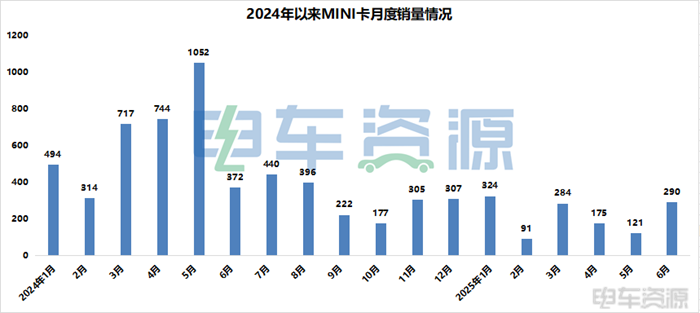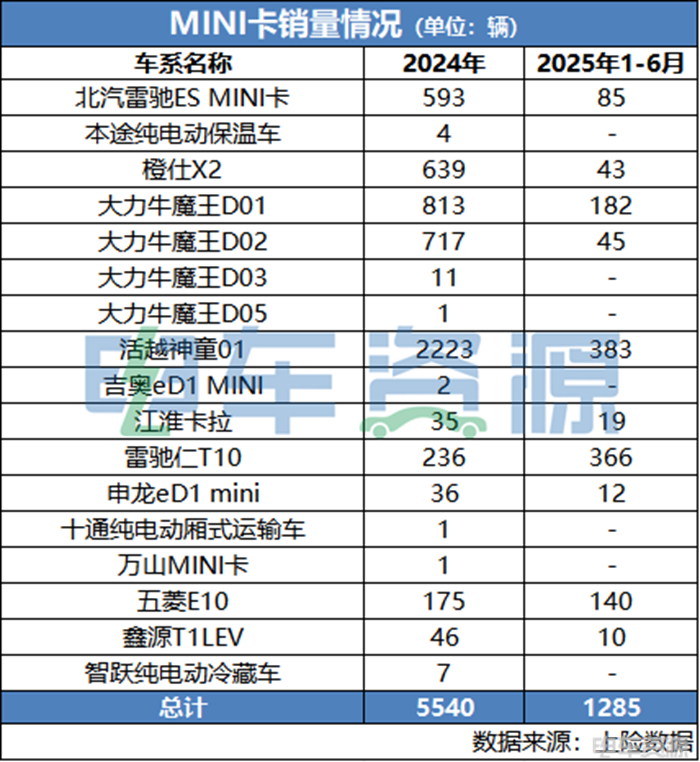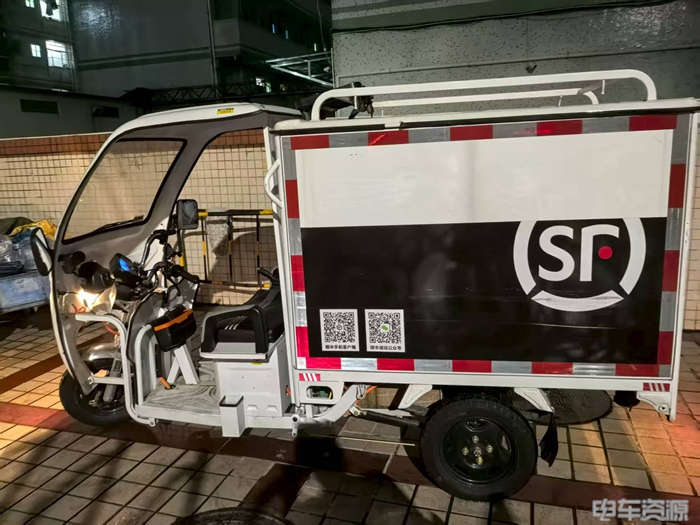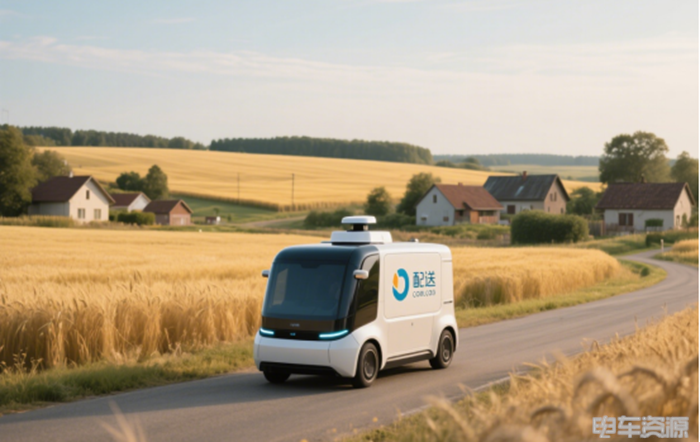After Driverless Cars, The MINI Truck That Just Can't Be Revived
The new energy MINI trucks were once highly anticipated and regarded as the ideal solution to the "last mile" delivery challenge. However, both the monthly sales figures and the production difficulties faced by manufacturers now reveal a worrying downturn in the performance of MINI trucks.
The MINI truck has never managed to replace the million-unit electric tricycle market as expected; instead, it is on the decline. Now, an even more disruptive challenge is looming—the rapid rise of unmanned delivery vehicles, which may well become the final straw that breaks the MINI truck market.
No demand market for MINI cards
Let's first look at a set of data.
In 2024, sales of new energy MINI trucks reached 5,540 units.By the first half of 2025, sales were only 1,285 units, less than a quarter of those in 2024.Year-on-year significant decline of 65%.
What is even more worrying is that from January to May 2024, the average monthly sales could still reach over 600 units, with a peak of 1,052 units. However, starting from June until the end of 2024, the average monthly sales have plummeted to around 300 units. By the first half of this year, the market stability of the MINI truck has become even worse.Monthly average sales are 200 vehicles.The month with the lowest sales had only 91 vehicles sold.

Not only is the market performance extremely pessimistic,Automakers seem to be abandoning this niche market.
Since 2025, the sales of most models have dropped to zero and exited the market. Models such as the Dali Bull Demon King D03/D05 and Jiaao eD1 MINI no longer have any sales. The once-prominent Huoyue Shentong 01 only has 383 units sold, and Dali Bull Demon King D01/D02 sold fewer than 200 units.

Various signs indicate that the current MINI card market is experiencing an unprecedented downturn.
The MINI car, which was once highly anticipated and expected to replace millions of electric tricycles,Why have I fallen to this point?
The most important thing is,MINI has consistently failed to find a clear market positioning.In the last-mile delivery sector, MINI trucks are not as flexible and convenient as electric tricycles, and in the urban freight transportation market, they struggle to compete with light trucks. The technical shortcomings, such as insufficient battery life and limited cargo space, have not been effectively overcome, making it difficult for MINI trucks to meet market demands in terms of logistics efficiency. This awkward situation of being "neither here nor there" has led to the market space for MINI trucks being continuously squeezed.

A delivery worker stated: "In the city, delivering packages with an electric tricycle is the most practical. The MINI truck is considered a motor vehicle, which means you have to drive on motor vehicle lanes, wait for traffic lights, and find parking spaces. However, a compliant electric tricycle doesn't have these issues; you can park it anywhere there's a space, and it navigates through old neighborhoods with ease."Traffic jams during peak hours do not exist.”
“Now compliant electric tricycles all come with insurance and license plates, making them safe and worry-free, and their cargo capacity isn’t much less than that of mini trucks,” another delivery worker admitted.
More importantly, the cost advantage of electric tricycles will be more prominent.The bare car price of a new energy MINI truck is around 40,000 to 60,000 yuan, and the price including insurance is at least over 50,000 yuan. In contrast, the on-road price of an electric three-wheeler starts at only 3,000 yuan.
For express logistics companies,Tricycles or four-wheeled vehicles are merely tools used for loading and transporting express deliveries; what they focus on more are the vehicle's practicality, cost-effectiveness, and compliance.As long as it can get on the road smoothly.
02 Fatal Impact Brought by Driverless Cars
While the MINI card was still searching for its market positioning, an even more disruptive challenge was approaching.
The rapid rise of unmanned delivery vehicles.
Early autonomous vehicles were mainly limited to testing within enclosed campuses, but now they are able to operate smoothly in complex urban environments. With continuous breakthroughs in key technologies such as 5G communication, high-precision positioning, and multi-sensor fusion, the reliability and adaptability of autonomous vehicles are rapidly improving.
At the same time, first-tier cities such as Beijing, Shanghai, and Shenzhen have successively introduced policies to open testing roads for autonomous vehicles. This policy orientation will further promote the commercialization process of autonomous vehicles.

Currently, companies such as JD.com, Meituan, and SF Express have deployed sizable fleets of unmanned delivery vehicles in multiple cities across the country. According to data from the State Post Bureau,As of 2024, the large-scale application of unmanned delivery vehicles in the express logistics sector has exceeded 6,000 units in total.Since the beginning of this year, more and more companies have been racing to expand their presence. For example, Neolix plans to deploy over 10,000 unmanned delivery vehicles nationwide this year. Clearly, the market's expectations for the application of unmanned vehicles go far beyond those for MINI trucks.
What is even more noteworthy is that,Unmanned delivery vehicles are being deeply integrated with new technologies such as intelligent warehousing.Building a comprehensive smart logistics system is a systemic advantage that traditional MINI cards can hardly match.
Although in the short term, MINI trucks may still maintain a certain survival space in remote areas and specific professional transportation fields, in the long run, as the cost of autonomous vehicles continues to decrease and their application scenarios continue to expand, the market space for MINI trucks will be continuously compressed. It is worth mentioning that...Autonomous vehicles are not merely a simple replacement for MINI cards; they are redefining the operational model of urban last-mile logistics. This paradigm shift will completely change the landscape of market competition.
03 Where does the future path lie?
For companies still persisting in the MINI card market, transformation is imperative. The possible future path lies in:
It is not recommended to develop products based on mainstream market demand.Product repositioning should be based on the logic of meeting the demand for personalized non-standard products.Collaborate with B-end corporate clients to develop exclusive models. Focus on exploring C-end user needs to create an innovative online participation in vehicle customization.Positioned as a commercial vehicle for urban young people starting businesses or side hustles.;
2. Proactively embrace change and accelerate technological upgrades to achieve breakthroughs in range and intelligent connectivity.Strategic transformation towards the autonomous vehicle sector.
No matter what choice is made, companies need to clearly recognize that the traditional MINI card business model is no longer sustainable.
In the future, as autonomous driving technology matures and the construction of smart cities progresses, urban last-mile logistics is undergoing profound changes. In this transformation, MINI trucks are likely to be gradually replaced by smarter and more efficient solutions, much like how feature phones were once replaced.Although this replacement process may take 3 to 5 years, the trend is already very clear.For industry participants, instead of struggling to survive in the shrinking traditional market, it is better to proactively embrace change and seek development opportunities in emerging fields.
After all, in the wave of technological innovation, only by following the trend can one win the future.
【Copyright and Disclaimer】The above information is collected and organized by PlastMatch. The copyright belongs to the original author. This article is reprinted for the purpose of providing more information, and it does not imply that PlastMatch endorses the views expressed in the article or guarantees its accuracy. If there are any errors in the source attribution or if your legitimate rights have been infringed, please contact us, and we will promptly correct or remove the content. If other media, websites, or individuals use the aforementioned content, they must clearly indicate the original source and origin of the work and assume legal responsibility on their own.
Most Popular
-

List Released! Mexico Announces 50% Tariff On 1,371 China Product Categories
-

EU Changes ELV Regulation Again: Recycled Plastic Content Dispute and Exclusion of Bio-Based Plastics
-

Clariant Unveils Cost-Cutting Plan Details, Plans to Shut Down Multiple Plants
-

Mexico officially imposes tariffs on 1,400 chinese products, with rates up to 50%
-

Nissan Cuts Production of New Leaf EV in Half Due to Battery Shortage






